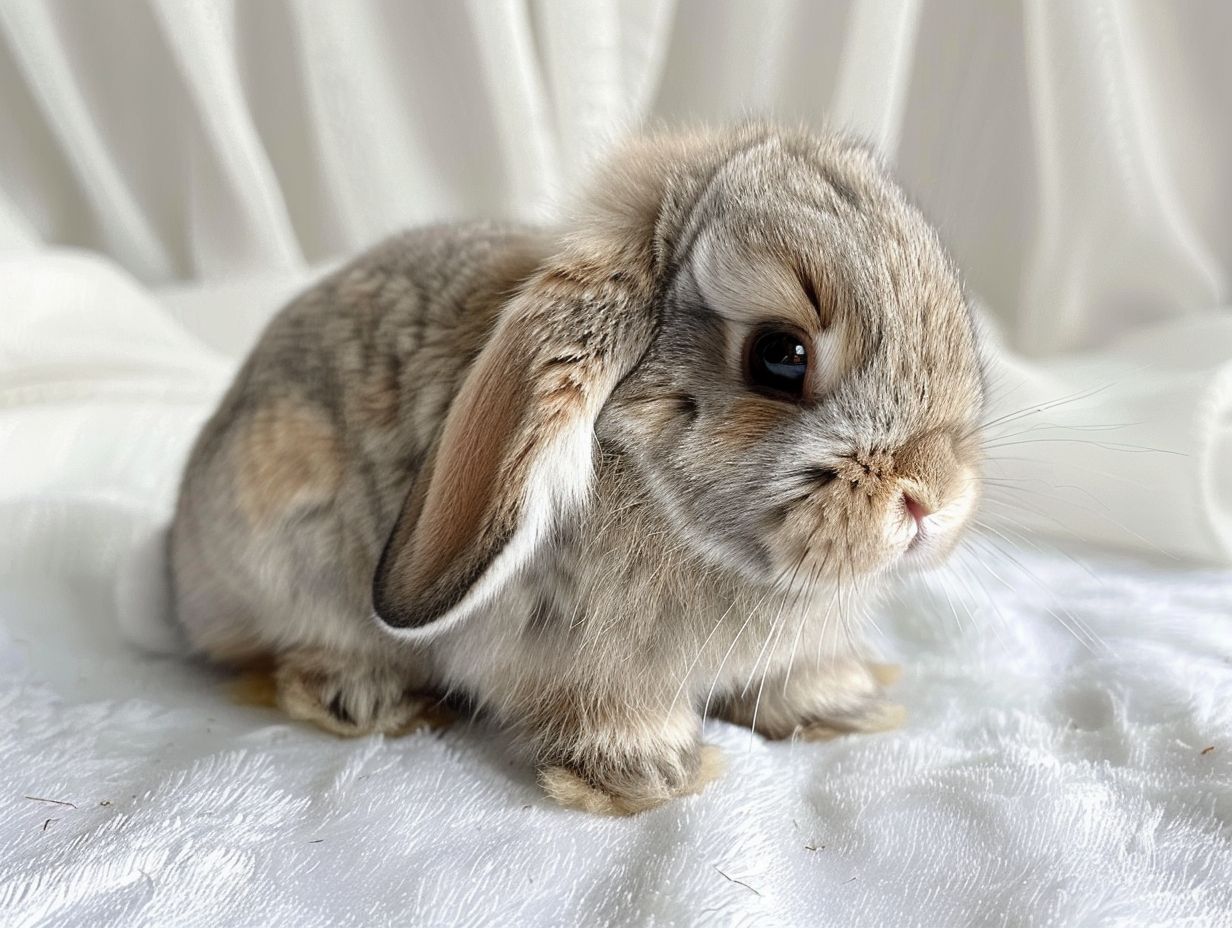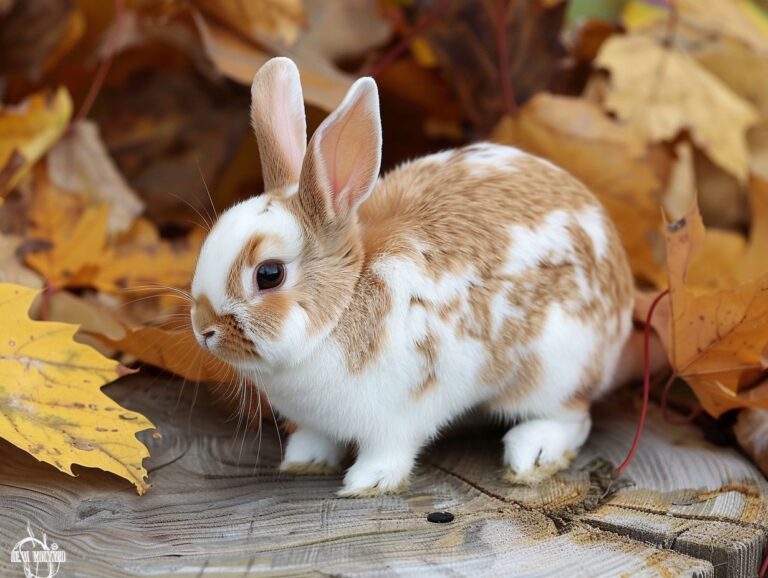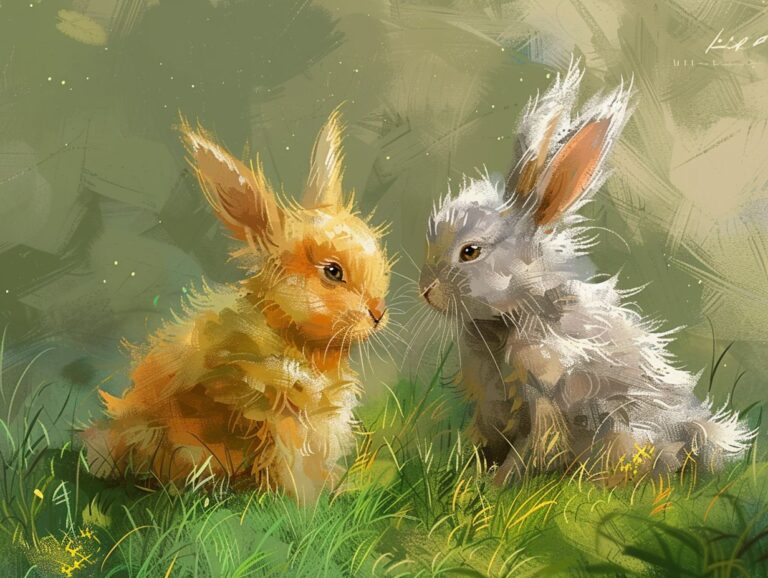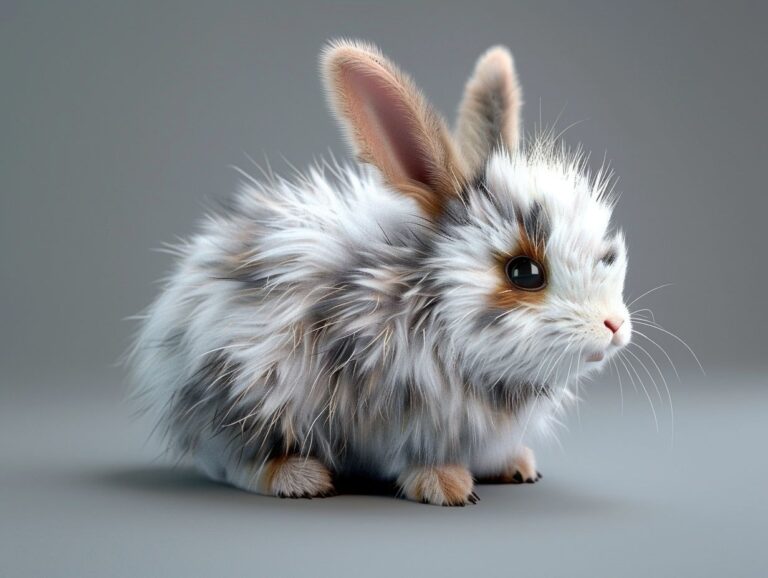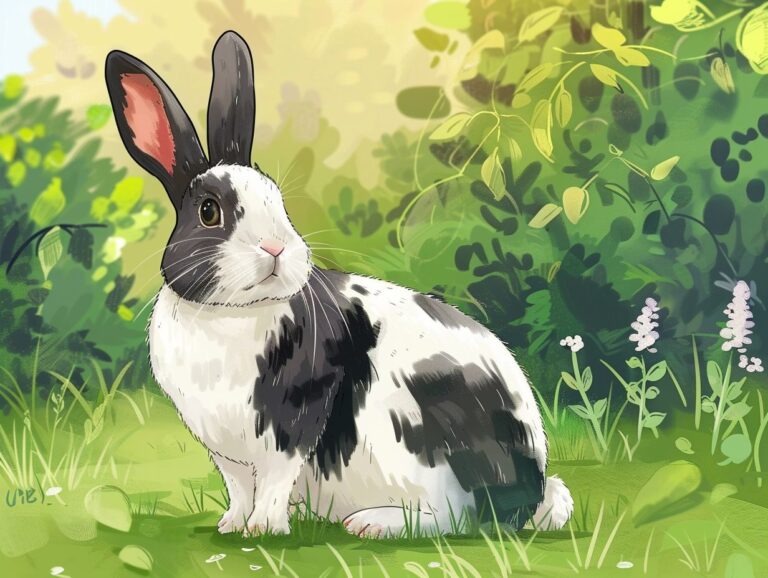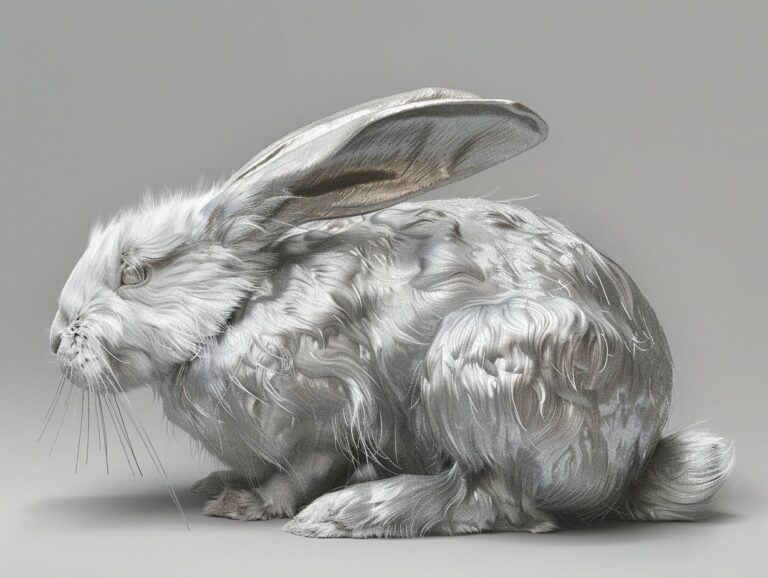Mini Lop Rabbit Breed: Characteristics, Care, History, and Breeding Practices
Considering getting a American rabbit breed as a pet but want to learn more about this adorable breed first?
This article covers everything you need to know about Mini Lop Rabbits, from their size and temperament to their history and breeding practices.
Discover the unique characteristics of these fluffy companions and learn how to properly care for them to ensure they live a happy and healthy life.
Let’s dive in!
Key Takeaways:
What Is A Mini Lop Rabbit?
A Mini Lop Rabbit, also known as a lop rabbit, is a small breed of domesticated rabbits characterized by their distinctive lop ears and compact size. They are popular as family pets for their cute appearance and intelligent behaviors.
Mini Lops typically weigh between 3 to 6 pounds, making them perfect for indoor living due to their manageable size. Their fur is soft and dense, coming in a variety of colors.
These rabbits have friendly and docile personalities, enjoying attention and gentle handling. Their playful nature makes them great companions for children and adults alike. To learn more about the Mini Rex rabbit breed, including their characteristics, care, history, and breeding practices, click here.
Mini Lop Rabbits are known for their social behavior and adapt well to living in a household environment. They thrive on interaction, making them ideal pets for families looking for a loving and interactive companion.
What Are The Characteristics Of A Mini Lop Rabbit?
Mini Lop Rabbits possess unique characteristics that include their small size, lop ears, and a variety of coat colors. These adorable creatures are known for their playful and sociable nature, making them beloved family pets.
- Due to their compact size, Mini Lop Rabbits are suitable for indoor living spaces, perfect for apartment dwellers or those with limited outdoor space.
- Their lop ears give them an endearing appearance, adding to their charm and appeal as pets.
- Mini Lops come in a wide range of coat colors, from solid shades like black, white, and brown, to more unique colors such as blue, fawn, and lilac.
- These bunnies have a friendly temperament, often seeking out human companionship and enjoying interaction with their owners.
Size and Weight
Mini Lop Rabbits are characterized by their small size and compact build, typically weighing between 3 to 6 pounds. Their petite stature adds to their charm and appeal as family pets.
These adorable rabbits boast a compact physique with short, sturdy bodies and rounded faces. Despite their small size, they have a solid build, giving them a robust appearance. Mini Lops are known for their well-proportioned features, including their ears that drop down by their sides. This breed’s ideal weight range is crucial for their overall health and well-being, with adult Mini Lops usually reaching full size by 6-9 months. Owners must monitor their diets and ensure they stay within the recommended weight range to prevent obesity and related health issues.
Coat and Color
Mini Lop Rabbits have a dense and soft coat that comes in various colors such as white, brown, black, and grey. Their coat texture and color variations contribute to their aesthetic appeal and uniqueness.
Mini Lop Rabbits exhibit diverse coat types that range from solid colors to highly intricate patterns, making them visually captivating. The feathered fur of Mini Lops adds a touch of elegance to their overall appearance, especially when coupled with irresistibly soft strands that are a delight to touch.
Their coat patterns may feature spots, agouti ticking, color blocks, or charming broken hues, each contributing to the rabbit’s individuality. Popular variations include the himalayan pattern that showcases darker points on ears, feet, and tail against a lighter body, and the holland lop pattern characterized by a solid base with white markings around the neck, nose, and paws.
Personality and Temperament
Mini Lop Rabbits are known for their friendly and sociable nature, often displaying affection towards their owners. They exhibit playful behaviors and can be trained to respond to commands, making them ideal as family pets.
These rabbits are intelligent creatures, known for their curious nature and adaptability to various environments.
Due to their social tendencies, they thrive in environments where they can interact with humans and other pets.
Their amicable demeanor makes them excellent companions for children and adults alike.
Mini Lop Rabbits are quick learners, making training sessions enjoyable and rewarding for both owners and pets.
What Is The History Of Mini Lop Rabbit Breed?

Mini Lop Rabbits were bred in the early 1970s by Bob Herschbach in the United States, further contributing to their expansion globally. The breed’s distinctive lopped ears and compact size make them a favorite choice for rabbit enthusiasts. Their friendly nature and social interaction with humans have endeared them to families as delightful companions. Due to their adaptability to indoor living, Mini Lop Rabbits have become one of the most sought-after rabbit breeds in the world.
How To Care For A Mini Lop Rabbit?
Caring for a Mini Lop Rabbit involves providing a suitable living environment, a balanced diet, regular grooming to maintain their coat, and ensuring ample exercise and playtime to keep them healthy and happy.
In terms of housing, Mini Lop Rabbits thrive in spacious cages or hutches with room to hop around and stand up on their hind legs without restriction. Ensure the bedding is soft, absorbent, and changed regularly to prevent health issues. Proper ventilation and protection from extreme temperatures are vital for their well-being.
- Grooming Mini Lop Rabbits involves brushing their coat at least a few times a week to prevent matting and remove loose fur, especially during shedding seasons.
- Dietary considerations call for a mix of hay, fresh vegetables, and high-quality pellets to meet their nutritional needs and promote good digestion.
- Exercise is crucial for their physical and mental health, so provide them with plenty of safe toys, tunnels, and opportunities to explore outside of their enclosure.
Housing and Environment
Mini Lop Rabbits should be housed in a secure and spacious enclosure that provides ample space for them to move around and play. It’s essential to protect them from potential predators and ensure a safe and comfortable living environment.
When setting up the enclosure for Mini Lop Rabbits, it’s crucial to consider factors like adequate ventilation to prevent respiratory issues, as these creatures are vulnerable to heat stress. Providing hiding spots and tunnels can offer them security and stimulation. Incorporating platforms or shelves for climbing and exploration can keep them mentally engaged. Utilizing non-toxic, chew-safe materials for their enclosure helps prevent accidents and health hazards. Maintaining a clean living space by regular litter changes and spot cleaning is necessary for their well-being.
Diet and Nutrition
A well-balanced diet is crucial for the health and well-being of Mini Lop Rabbits. Their diet should consist of fresh hay, leafy greens, vegetables, and a limited amount of pellets to ensure they receive essential nutrients for optimal health.
Hay is an essential component of a lilac rabbit breed’s diet as it provides necessary fiber for their digestive system and helps maintain healthy teeth. Leafy greens such as kale, spinach, and parsley are rich in vitamins and minerals, promoting overall well-being. Vegetables like carrots and bell peppers offer additional nutrients and variety to their meals.
Pellets should be given sparingly as they are concentrated sources of nutrition but should not be the primary food source. Providing a varied diet ensures that Mini Lop Rabbits get a balance of nutrients for their energy levels and growth.
Grooming and Hygiene
Regular grooming is essential to maintain the health and cleanliness of Mini Lop Rabbits. Grooming includes brushing their coat, trimming nails, and checking for any signs of skin issues or parasites to prevent potential diseases.
Brushing the Mini Lop’s plush coat regularly not only helps distribute natural oils for a healthy sheen but also prevents matting and reduces shedding around your home.
Nail trimming is crucial as overgrown nails can cause discomfort or even lead to infections.
Performing routine skin checks can help detect early signs of mites, dermatitis, or other skin ailments, ensuring prompt treatment and preventing further complications.
Maintaining these grooming practices is not only beneficial for their appearance but also vital for their overall well-being.
Exercise and Playtime
Mini Lop Rabbits require daily exercise and playtime to stay active and mentally stimulated. Providing them with toys, tunnels, and interactive activities can help prevent boredom and encourage natural behaviors.
These rabbit companions have a playful and curious nature, making it essential for their well-being to engage in physical and mental activities.
Activities such as hiding treats inside puzzle toys or creating a cardboard maze can stimulate their minds while keeping them physically active.
Mini Lop Rabbits enjoy exploring new environments, so setting up playpens or allowing supervised outdoor playtime can provide them with a change of scenery.
What Are The Breeding Practices For Mini Lop Rabbits?

When selecting breeding stock for Mini Lop Rabbits, it’s essential to choose healthy, purebred rabbits with desirable characteristics such as good temperament, conformation, and fur quality.
For mating procedures, it’s recommended to introduce the doe to the buck’s environment to reduce stress and increase the chances of successful mating. Monitoring the mating process and ensuring that it occurs at the right time is crucial for a successful mini lop rabbits as pets breeding outcome.
During pregnancy, providing a comfortable, stress-free environment for the pregnant doe and closely monitoring her nutrition and health is essential to ensure the well-being of both the mother and kits.
Health considerations play a vital role in breeding practices, with regular veterinary check-ups, proper hygiene, and disease prevention measures being key aspects to safeguard the overall health of the breeding rabbits and their offspring.
Selecting Breeding Stock
When selecting breeding stock for Mini Lop Rabbits, it’s essential to choose healthy and genetically diverse rabbits that exhibit desirable traits such as good temperament, strong build, and lop ears characteristic of the breed.
Along with physical traits, it is crucial to consider the lineage and health history of the potential breeding rabbits. Genetic diversity plays a vital role in ensuring the overall health and vigor of the offspring. By selecting rabbits from different bloodlines, you can help prevent inbreeding and reduce the risk of genetic disorders.
Assessing the rabbits’ overall health status, including checking for common health issues prevalent in Mini Lop Rabbits, is imperative to maintain a thriving and resilient breeding population. Regular veterinary check-ups and proper nutrition are key aspects to consider when evaluating potential breeding stock.
Mating and Pregnancy
Mating and pregnancy in Mini Lop Rabbits should be carefully managed to ensure successful reproduction and the health of the mother and offspring.
Proper breeding techniques include introducing the male and female rabbits in a neutral territory to reduce stress and increase the likelihood of successful mating. The gestation period for Mini Lop Rabbits typically lasts between 28 to 31 days, during which time the pregnant doe should be provided with a quiet and secure nesting area where she can prepare for giving birth. Prenatal care for the pregnant rabbit involves providing a balanced diet rich in fiber, hay, fresh vegetables, and clean water to support her nutritional needs and the development of the kits.
Caring For The Mother and Kits
Proper care for the mother and kits after birth is essential for the health and survival of Mini Lop Rabbit offspring. Providing a comfortable nesting area, monitoring the mother’s well-being, and ensuring proper nutrition are key aspects of postnatal care.
Creating a cozy nest for the mother to nurse and bond with her babies is crucial. It should be secluded from noise and disturbance to reduce stress on the new family members. Keeping the nesting area clean and dry is vital to prevent infections in the kits. Maternal health should be closely observed, checking for any signs of illness or complications.
On the nutritional front, offering the mother a diet rich in fresh hay, vegetables, and limited pellets supports her milk production and overall well-being. For the kits, ensuring they have continuous access to their mother’s milk helps them grow strong and healthy.
Weaning and Separation
Weaning and separation of Mini Lop Rabbit kits from the mother should be done gradually to ensure a smooth transition.
Ensuring a gradual weaning process is essential for the well-being of Mini Lop Rabbit kits. During this stage, it is important to closely monitor the rabbits’ development to ensure they are adapting to the changes smoothly. Gradual weaning helps the kits transition to independent feeding and reduces stress levels, promoting overall health.
Post-weaning care plays a crucial role in the growth of young rabbits. Providing a balanced diet rich in fiber and nutrients is vital for their development. Creating a safe and comfortable environment after separation from the mother is fundamental in ensuring the well-being of the kits.
Health Considerations For Breeding
Maintaining optimal health during breeding is essential for the success of Mini Lop Rabbit reproduction. Regular health checks, vaccination schedules, and disease prevention measures are critical aspects of ensuring the overall well-being of the breeding rabbits.
Preventive measures such as providing a clean and hygienic living environment for the rabbits, ensuring a balanced diet rich in nutrients, and offering ample space for exercise contribute significantly to their health. Regular monitoring of weight, fur condition, and behavior can help detect any early signs of illness. Veterinary care plays a crucial role in managing the breeding rabbits’ health, as professionals can provide expert guidance on nutrition, hygiene, and potential health issues. For more information on Holland Lop rabbit breed, you can explore characteristics, care, history, and breeding practices.
Frequently Asked Questions
What are the characteristics of the Mini Lop rabbit breed?
The Mini Lop rabbit breed is known for its small size and round, compact body. They have lop ears that hang down and come in a variety of colors such as white, black, brown, and gray. They have a friendly and docile temperament, making them great pets for families.
How should I care for my Mini Lop rabbit?
Mini Lop rabbits require daily grooming to keep their coats soft and healthy. They should also have unlimited access to fresh hay, water, and a balanced diet of pellets and vegetables. Regular exercise and playtime is important for their physical and mental well-being.
What is the history of the Mini Lop rabbit breed?
The Mini Lop breed was developed in Germany in the 1970s by crossing the German Lop and the small Chinchilla rabbit. They were first introduced to the United States in the 1980s and have since become a popular breed for both show and companion animals.
Are Mini Lop rabbits suitable for breeding?
Yes, Mini Lop rabbits can be bred, but it is important to do so responsibly. Breeding should only be done by knowledgeable and ethical breeders who prioritize the health and well-being of the rabbits. It is also important to find suitable homes for any offspring that are not kept for breeding purposes.
How often do Mini Lop rabbits reproduce?
Mini Lop rabbits can reproduce year-round, with a gestation period of 28-31 days. They can have litters of anywhere from 2 to 10 kits, and can produce multiple litters in a year. However, it is recommended to allow them to rest between breeding to maintain their health.
Do Mini Lop rabbits have any specific breeding practices?
When breeding Mini Lop rabbits, it is important to consider genetic diversity and avoid inbreeding. It is also recommended to have a veterinarian check the health of both the male and female rabbits before breeding, and to provide a safe and comfortable environment for the mother and her kits.

